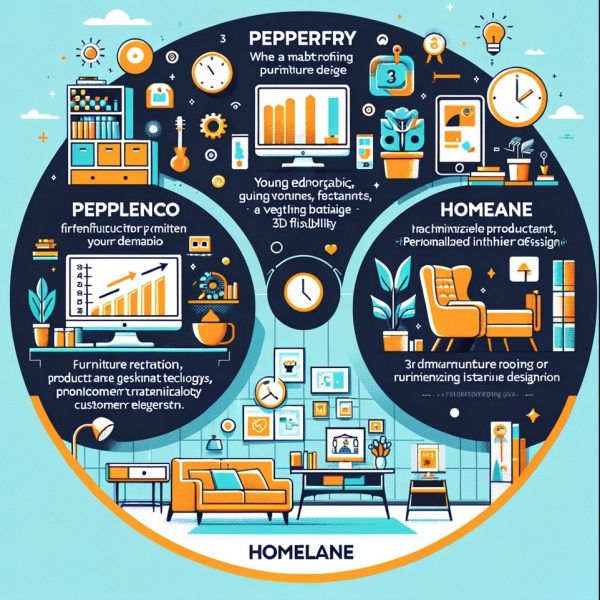Indian furniture and home decor market: Furlenco vs. Pepperfry vs. Homelane
March 31, 2024
Industry: Furniture
Subject: Startups

While Furlenco, Pepperfry, and HomeLane operate in overlapping but distinct segments of the furniture and home decor market, each has developed a unique value proposition:
- Furlenco appeals to the mobility and flexibility preferences of younger demographics, emphasizing convenience and adaptability.
- Pepperfry leverages its vast product range and marketplace model to cater to a wide range of consumer preferences and price points.
- HomeLane focuses on personalized, technology-driven interior design solutions, emphasizing customer involvement and innovation.
In the context of the Indian furniture and home decor market, Furlenco, Pepperfry, and HomeLane represent three distinct but interrelated segments: furniture rental, online furniture retail, and interior design services, respectively. Each has carved out a niche based on specific consumer needs and market dynamics. Here, I will provide an in-depth analysis of these three companies, highlighting their business models, market positions, competitive strategies, and recent developments.
Furlenco
Founded in 2012, Furlenco is a Bangalore-based startup offering furniture rental services, primarily targeting young professionals and people who prefer not to commit to long-term furniture purchases. This model is particularly attractive in a country with a large young demographic and a growing number of mobile professionals.
Business Model: Furlenco’s model is subscription-based, offering a range of furniture and home decor items for a monthly fee. This service includes free delivery, setup, and even swaps, making it a flexible option for its target market.
Market Position: As a pioneer in the furniture rental space in India, Furlenco has established a strong brand presence and customer base. It is seen as a youthful, flexible, and customer-centric brand.
Competitors: While Furlenco’s direct competitors include other furniture rental services like Rentomojo, it also indirectly competes with furniture retailers and second-hand markets.
Investors and Valuation: Furlenco has raised significant funding over the years, with investors recognizing the potential in the growing rental economy. The valuation has been growing, reflecting the company’s success and market potential. For Furlenco, the company raised $140 million in a Series D round, which included a mix of debt and equity. This financing round, led by Zinnia Global Fund, brought the total capital raised by Furlenco to over $240 million. While the specific post-money valuation from this round was not disclosed, the scale of investment and the company’s growth plans suggest a significant valuation. It’s worth noting that the furniture rental market, where Furlenco operates, is seen as a substantial opportunity, estimated to be worth over $4.5 billion
Recent Developments: Furlenco has been expanding its product range, geographic reach, and customer segments, including venturing into more premium offerings and B2B services.
Pepperfry
Established in 2011, Pepperfry is one of India’s leading online furniture and home products marketplaces, offering a wide range of products from various brands and merchants.
Business Model: Pepperfry operates on a marketplace model, connecting furniture and home decor manufacturers and sellers with consumers. It also offers value-added services like assembly assistance and interior design consultancy.
Market Position: As one of the early entrants in the online furniture retail space in India, Pepperfry has a vast product catalog and enjoys high brand recognition.
Competitors: Competitors include other online furniture retailers like Urban Ladder (acquired by Reliance Industries) and offline players like IKEA and local furniture stores.
Investors and Valuation: Pepperfry has attracted substantial investment, reflecting investor confidence in its business model and growth potential.
Pepperfry has been making strategic moves to strengthen its position in the Indian furniture market. They secured $23 million in funding, aiming to enhance their omnichannel presence and supply chain capabilities to better serve their expanding customer base. The company has raised over $230 million to date, with a notable investment round intending to bolster various aspects of its business, from technological innovation to supply chain enhancements .
Additionally, there have been expectations around Pepperfry achieving a unicorn status with a valuation of over $1 billion as it approaches its potential IPO. This aspiration indicates Pepperfry’s significant growth trajectory and its strategic focus on expansion and profitability
Recent Developments: The company has been focusing on expanding its offline presence through Pepperfry Studios, enhancing customer experience, and integrating technology like AR/VR for better product visualization.
HomeLane
Launched in 2014, HomeLane offers personalized interior design services and solutions, catering to homeowners’ diverse needs.
Business Model: HomeLane’s model combines technology and personalization, offering end-to-end interior design services from design consultation to execution, leveraging its proprietary 3D visualization tool, SpaceCraft.
Market Position: HomeLane has positioned itself as a tech-driven, customer-focused brand in the home interior solutions space, differentiating through personalized service and technological innovation.
Competitors: Competitors include other interior design firms like Livspace, Design Cafe, and traditional interior design consultants and contractors.
Investors and Valuation: HomeLane has raised significant funding, indicating strong investor interest in the home interiors segment.
For HomeLane, recent funding rounds and growth metrics highlight its ambitious trajectory in the home interior market. In a significant Series E funding event, HomeLane raised $50 million, showcasing strong investor confidence. This round was led by IIFL AMC along with participation from other significant investors, marking a pivotal moment for the company as it aims to expand and enhance its services further.
In June 2023, HomeLane raised an additional Rs 75 crore in a bridge funding round. This capital injection is aimed at accelerating HomeLane’s growth and supporting its plans for expansion. The funding is part of HomeLane’s continued effort to strengthen its market position and reach profitability. The company reported robust growth, with a 34% increase in revenue year-on-year, and it has been focusing on scaling its affordable segment brand, Doowup, as part of its broader market strategy
Recent Developments: HomeLane has been investing in technology to enhance its design and execution capabilities and expanding its footprint in various Indian cities.








